
The Canary Islands, also known informally as the Canaries, are a Spanish region, autonomous community and archipelago in the Atlantic Ocean. At their closest point to the African mainland, they are 100 kilometres west of Morocco and the Western Sahara. They are the southernmost of the autonomous communities of Spain. The islands have a population of 2.2 million people and are the most populous special territory of the European Union.
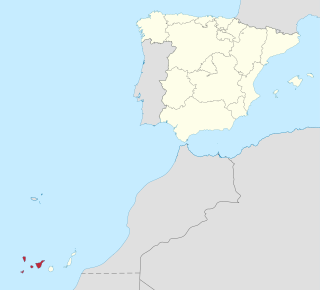
Province of Santa Cruz de Tenerife, also Province of Santa Cruz, is a province of Spain, consisting of the western part of the autonomous community of the Canary Islands. It consists of about half of the Atlantic archipelago: the islands of Tenerife, La Gomera, El Hierro, and La Palma. It occupies an area of 3,381 km2 (1,305 sq mi). It also includes a series of adjacent roques.
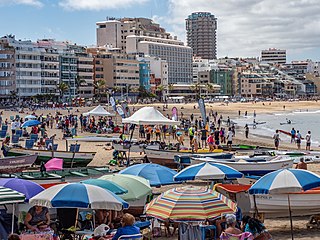
Las Palmas, officially Las Palmas de Gran Canaria, is a Spanish city and capital of Gran Canaria, in the Canary Islands, in the Atlantic Ocean.

Gran Canaria, also Grand Canary Island, is the third-largest and second-most-populous island of the Canary Islands, an archipelago off the Atlantic coast of Northwest Africa and is part of Spain. As of 2023 the island had a population of 862,893 that constitutes approximately 40% of the population of the archipelago. Las Palmas de Gran Canaria, the capital of the island, is the biggest city of the Canary Islands and the ninth of Spain.

Tenerife is the largest and most populous island of the Canary Islands. It is home to 42.9% of the total population of the archipelago. With a land area of 2,034.38 square kilometres (785.48 sq mi) and a population of 948,815 inhabitants as of January 2023, it is also the most populous island of Spain and of Macaronesia.

Santa Cruz de Tenerife, commonly abbreviated as Santa Cruz, is a city, the capital of the island of Tenerife, Province of Santa Cruz de Tenerife, and one of the capitals of the Canary Islands, along with Las Palmas. Santa Cruz has a population of 206,593 (2013) within its administrative limits. The urban zone of Santa Cruz extends beyond the city limits with a population of 507,306 and 538,000 within urban area. It is the second largest city in the Canary Islands and the main city on the island of Tenerife, with nearly half of the island's population living in or around it.

Santa Cruz de la Palma is a city and a municipality on the east coast of the island of La Palma in the province of Santa Cruz de Tenerife of the Canary Islands. Santa Cruz de la Palma is the second-largest city and is the capital of the island. It is along an old lava flow coming from the Caldereta, a volcano just south of the city. Santa Cruz de La Palma has the privilege of having the first democratically elected town hall in Spain.

Tenerife Tram is a light rail or tram service located on the island of Tenerife, one of the Canary Islands in Spain. It is operated by Metropolitano de Tenerife, a limited company now 100% owned by Cabildo de Tenerife. Service started on 2 June 2007 over a 12.5-kilometre (7.8 mi) route that linked the Intercambiador in Santa Cruz de Tenerife with Avenida de la Trinidad in La Laguna. A second line between La Cuesta and Tíncer opened in 2009. It is the only existing tramway or train in the Canary Islands.
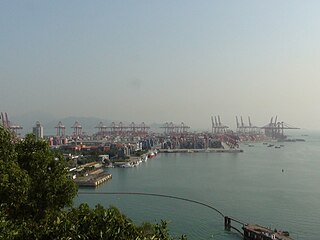
The Port of Shenzhen is the collective name of a number of ports the coastline of Shenzhen, Guangdong Province, China. These ports as a whole form one of the busiest and fastest growing container ports in the world.

On the island of Tenerife, in the Canary Islands, many sports are practiced, both outdoors and indoors in the various facilities available throughout the island.

The Auditorio de Tenerife "Adán Martín" is an auditorium in Santa Cruz de Tenerife, Canary Islands, Spain. Designed by architect Santiago Calatrava, it is located on the Avenue of the Constitution in the Canarian capital, and next to the Atlantic Ocean in the southern part of Port of Santa Cruz de Tenerife. Construction began in 1997 and was completed in 2003. The auditorium was inaugurated on 26 September of that year in the presence of Felipe, Prince of Asturias, and was later visited by former U.S. President Bill Clinton. The building is framed within the tenets of late-modern architecture of the late 20th century.

The Rascacielos de la avenida Tres de Mayo is a skyscraper in the city of Santa Cruz on the Tenerife, Canary Islands, Spain, located on Avenida Tres de Mayo.

Puerto de la Cruz is a city and municipality in the northern part of the island of Tenerife, Canary Islands, Spain. It was formerly known by its English translation, "Port of the Cross", although now it is known by its Spanish name in all languages. Puerto de la Cruz is located on the northern coast, 4 km (2 mi) northwest of La Orotava and 30 km (19 mi) west of Santa Cruz de Tenerife. The TF-5 motorway passes through the municipality. The population is 30,483 (2018). In Spanish, the local inhabitants are known as Portuenses. With an area of 8.73 km2 (3 sq mi), the municipality is the smallest in Tenerife. The elevation of the town's centre is 9 m (30 ft) above sea level and the highest point being Las Arenas, a volcanic cone with an elevation of 249 m (817 ft).

Punta Cumplida Lighthouse is an active 19th century Spanish lighthouse on the Canary island of La Palma in the municipality of Barlovento. Punta Cumplida is the oldest of the four main lighthouses on La Palma, each one being located near to a different cardinal point of the island. Punta Cumplida marks the north-eastern tip; Fuencaliente the southern point, and the two modern lighthouses at Punta Lava and Arenas Blancas, the eastern and western points respectively.

The Punta Rasca Lighthouse is an active lighthouse in the municipality of Arona on the Canary Island of Tenerife. The current lighthouse was the second to be constructed on the headland of Punta Rasca, which is located close to the most southerly point on the island at Punta Salemas. It lies between the Punta Abona Lighthouse to the northeast and the Punta de Teno Lighthouse of Buenavista del Norte to the northwest.
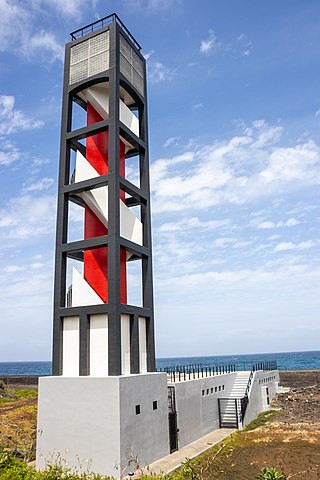
The Puerto de la Cruz Lighthouse is an active lighthouse in Puerto de la Cruz on the northern coast of Tenerife in the Canary Islands. This modern lighthouse is situated within a seafront car park, to the west of the small port in the town. It is one of seven lighthouses which mark the coastline of Tenerife, and lies between two other modern lighthouses of Punta del Hidalgo to the northeast, and Buenavista to the west.

The Buenavista Lighthouse, also known as the Punta de Buenavista lighthouse is an active lighthouse in the municipality of Buenavista del Norte on the northern coast of Tenerife in the Canary Islands.
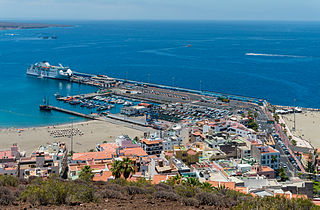
The Port of Los Cristianos is a port of the Atlantic Ocean located in the town of Los Cristianos, in the municipality of Arona on the island of Tenerife. It is administered by the Port Authority of Santa Cruz de Tenerife. It is the port with the highest passenger and vehicle traffic in the Canary Islands, in 2007 it had 1,829,579 passengers, and 238,836 vehicles.

The Puerto Industrial de Granadilla is a port located in the municipality of Granadilla de Abona in the southeast of the island of Tenerife (Spain). It is a complementary work of the port of Santa Cruz de Tenerife and intended to provide necessary facilities to different types of traffic, attract new traffic and cover increases. It is the largest industrial port of the Canary Islands.
As in the rest of Spain, the majority religion in the Canary Islands is the Catholic Church. The Catholic religion has been the majority since the Conquest of the Canary Islands in the fifteenth century. This religion would largely replace the Canarian aboriginal religion through the prohibition of the latter and syncretism. According to a survey conducted in 2019, Canary Islands is the fifth autonomous community in Spain with the highest percentage of people who declare themselves to be Catholics after the Region of Murcia, Extremadura, Galicia, Aragon, and Castile and León. 76.7% of the population is Catholic.





















